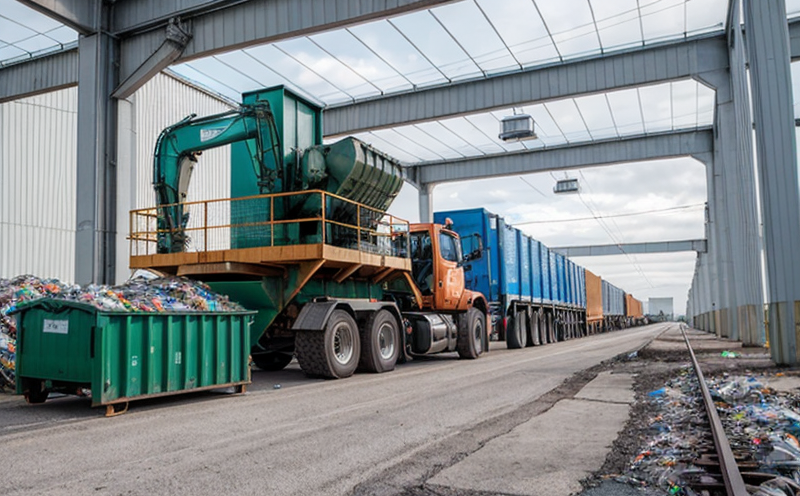EN 45555 Waste Treatment Process Testing in Recycling
The European standard EN 45555:2018, titled "Waste treatment processes — Determination of the recovery rate and energy input," is a critical tool for ensuring that waste recycling processes are both efficient and environmentally sustainable. This standard provides methodologies to measure the efficiency of various waste treatment methods in terms of material recovery rates and energy consumption.
The standard applies primarily to industrial manufacturing and processing sectors, where the focus on circular economy principles is paramount. In these industries, reducing waste generation, reusing materials, and recovering valuable resources are key objectives. EN 45555 supports this by offering a standardized approach to assess how well these goals are being met.
The process involves multiple steps that ensure accuracy and reliability of the results. First, the type and amount of waste entering the treatment process must be precisely quantified. This is followed by monitoring the treatment process itself, which includes various stages such as sorting, shredding, and chemical treatment. The final step is to evaluate the output materials for their recoverability and energy input during the entire process.
For instance, in a recycling facility that processes plastics from electronic waste (e-waste), the standard would help determine how much plastic can be recovered after undergoing various treatments like shredding and sorting. It also evaluates the energy consumed at each stage of processing to ensure it is minimized while achieving effective recovery.
Understanding the nuances of EN 45555 requires knowledge of both the technical aspects involved in waste treatment processes and the broader context of circular economy principles. This standard not only aids in improving operational efficiency but also contributes significantly to reducing environmental impact by promoting resource conservation and sustainable practices.
The widespread adoption of such standards across industries ensures a level playing field, allowing companies to compare their performance against industry benchmarks. For quality managers, compliance officers, R&D engineers, and procurement professionals, familiarity with EN 45555 can lead to better decision-making processes that align with sustainability goals.
Moreover, this standard plays an essential role in fostering innovation within the recycling sector by providing a framework for continuous improvement. By regularly reviewing and updating recovery rates and energy inputs, facilities can identify areas for optimization and implement more efficient practices.
Why It Matters
The importance of EN 45555 cannot be overstated in today's world where environmental consciousness is increasingly driving business strategies. This standard serves as a cornerstone for ensuring that waste recycling processes are not only effective but also sustainable and efficient.
One significant aspect highlighted by this standard is the measurement of material recovery rates. By accurately quantifying what percentage of input materials can be recovered, it becomes possible to track progress towards sustainability goals. This metric helps facilities understand their current performance and set realistic targets for improvement.
The energy input component of EN 45555 also holds great significance as it directly impacts the overall efficiency of recycling processes. Minimizing the amount of energy required for treatment can lead to significant cost savings while reducing greenhouse gas emissions. This dual focus on material recovery and energy efficiency ensures that facilities are operating at optimal levels, thereby contributing positively to environmental sustainability.
Another crucial benefit of adhering to EN 45555 lies in its role as a benchmark for best practices within the recycling industry. By setting clear guidelines on how waste treatment processes should be conducted, this standard encourages companies to adopt innovative approaches that enhance both operational efficiency and environmental responsibility.
For businesses involved in industrial manufacturing and processing, especially those committed to circular economy principles, compliance with EN 45555 offers a competitive edge. It demonstrates commitment to sustainable practices, which can appeal to eco-conscious consumers and stakeholders alike. Additionally, it facilitates smoother interactions between suppliers and customers by providing common ground for discussions about quality standards.
Overall, the implementation of this standard contributes significantly to fostering a more circular economy where resources are used sustainably and efficiently. It encourages responsible waste management practices that minimize environmental impact while maximizing economic benefits.
International Acceptance and Recognition
- EN 45555:2018 has gained widespread recognition among European countries, ensuring consistency in waste treatment process testing across borders.
- The standard is also accepted by several non-EU nations, particularly those involved in international trade and environmental agreements.
- A number of global organizations have endorsed EN 45555 due to its alignment with broader sustainability initiatives.





